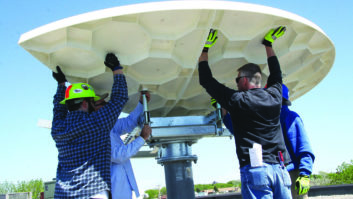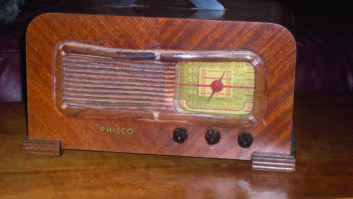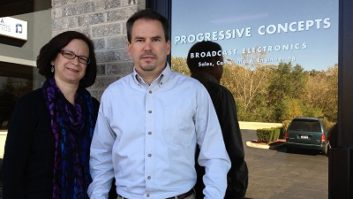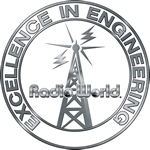(click thumbnail)Master Control RoomA desire to efficiently leverage its multimedia assets led the Associated Press to consolidate its Washington operations under one roof.
The new facility contains AP radio, TV, Internet, wire and photo services. It occupies 82,314 square feet across four floors, including 55,000 square feet of raised flooring. Four hundred forty-seven people work in the new building; the move was complete around the end of 2007.
Steve Kuhn, director of broadcast engineering, said key equipment was supplied by SAS, which provided control surfaces and routing; with Netia delivering control and production software
The radio side consists of two on-air studios, two production rooms and a tracking booth. On the two news floors are more than 70 video and audio workstations and 34 networked full-resolution digital editing stations, which also can contribute audio. AP engineers have done the studio configurations, while Professional Products of Gaithersburg, Md., was the systems integrator.
The satellite antenna farm on the roof is impressive. Included is a full-arc Simulsat-5 C/Ku antenna, one of the biggest in downtown Washington, capable of receiving simultaneous transmissions from dozens of satellites, along with three other large dishes.
(click thumbnail)Associated Press NewsroomThe IT center for the complex is a 1,000 square foot area with 100 equipment racks. To this center are more than 400 multi-screen desktops connected via gigabit Ethernet. More than 1,000 television monitors are scattered throughout the building.
Although a TDM routing system such as the SAS greatly simplifies wiring, the cabling infrastructure for the AP facility is still enormous.
“There are more than three miles of 4 inch conduit, more than four miles of electrical cable, more than a mile of mechanical piping and more than 1,200 miles of data cable,” Kuhn said.
Backup power comes from a generator with more than 24 hours of fuel capacity, along with two UPS systems. The AP complex has its own AC feed, separate from that used by the rest of the building. The generator was set on the roof using the largest mobile crane available on the east coast.
(click thumbnail)Radio Studio 52While the amount of equipment and infrastructure in a facility this size is impressive, Kuhn emphasized that it takes more than hardware to keep AP running.
Software is a vital component of the new AP facility. The one-stop front end for AP news editors and producers working on PCs is its ENPS, or the Electronic Newsroom Production System. Jason Smith, ENPS project manager, said, “This software serves as a common point for all media, not just audio. With ENPS, journalists can read and write stories, and look at audio files without having to switch applications.”
Added flexibility comes through using ENPS with MOS. Media Object Server Communications Protocol is an open-standard protocol for communications between newsroom computer systems and media object servers such as video servers, audio servers, still stores and character generators. In the case of AP, MOS connects ENPS to Netia, allowing AP producers to browse automation and edit assets in the database.
(click thumbnail)Rack Room/Tech CoreSmith said that while ENPS fully integrates different media, archives are scattered across the globe, with AP having video archives in London, New York and Washington.
Smith added that ENPS has an 11-year history, and was developed by AP in response to a request from the BBC. Now the program has more than 50,000 users in more than 50 countries. Users include the BBC, ESPN, CBS and NPR.
Tell RW about your facility project. E-mail [email protected].















